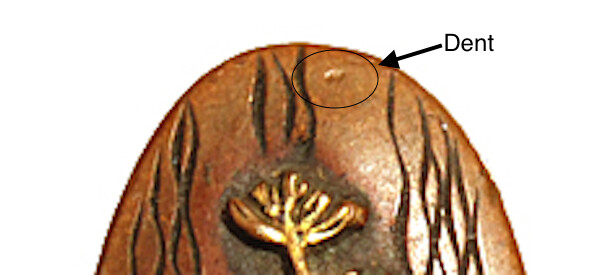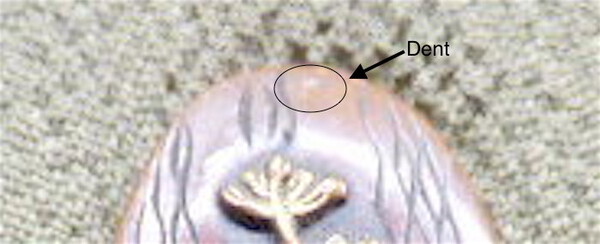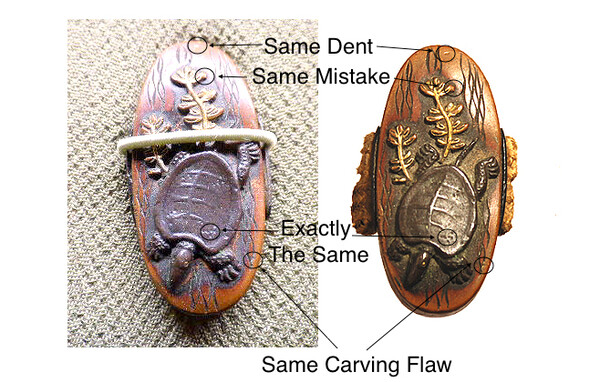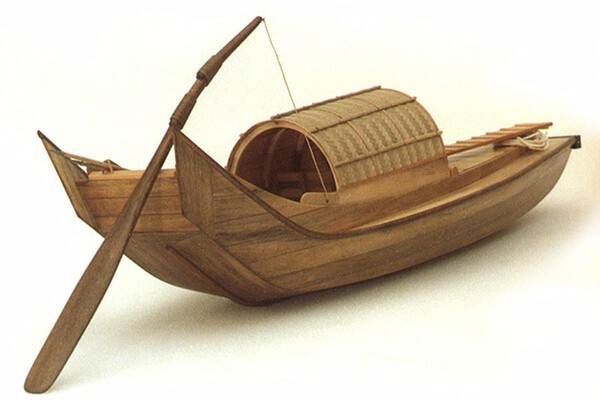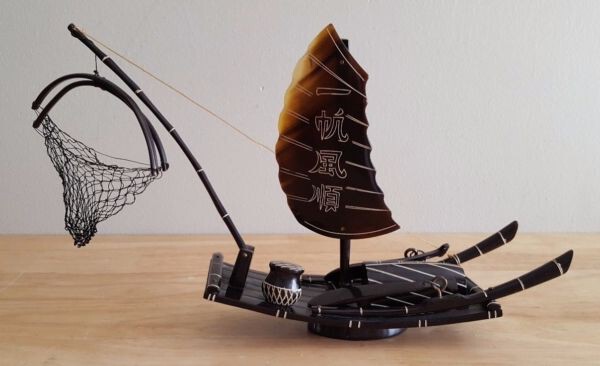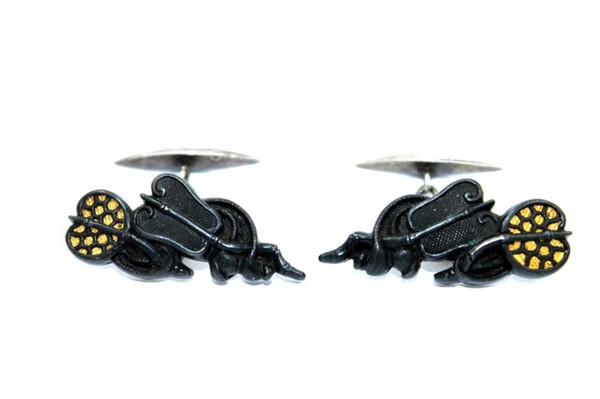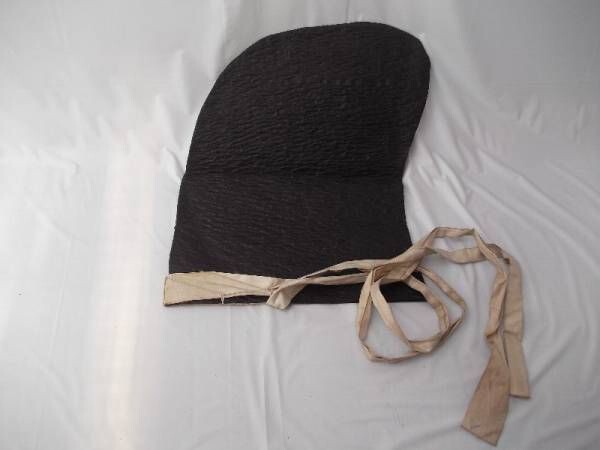-
Posts
858 -
Joined
-
Last visited
-
Days Won
7
Content Type
Profiles
Forums
Events
Store
Downloads
Gallery
Everything posted by Tanto54
-
As I mentioned to Chris in a PM. Why doesn't he just post pictures of the Fuchi? Surely his German Collector friend has sent him pictures of the Fuchi too. The one from Nihontocraft has distinctive staining/patina on the Tenjogane and scratches that would settle whether it was the same set or not. I believe that the answer is clear - there are many "defects" that are the same in both pictures, and I cannot see any differences (when accounting for camera perspective and glare). I've provided one example below (please look back at the original pictures because these have lost some quality in processing). Even if one was a "faithful" copy of the other, the artist would not copy a dent (unless it was a very famous piece, which this is not...) The inlayed turtles could be cast from the same mold (thus explaining the identical flaws), but the main part of the Kashira does not appear to be cast so a duplicate dent means its the same piece in different photos (no Alex, a dent is not part of the "design"). I hope that none of you who believe these are different pieces work for law enforcement CSI teams....
-
Dear Chris, The points that you compare are actually exactly the same (just slightly different camera perspectives and glare). Axel, the "three vertical strokes" at the bottom that you mentioned are also exactly the same. You can lead a horse to water....
-
Dear Axel, Please look closely at the pictures. Look at the dents and flaws - they are the same in both pictures (see below). Therefore, it must either be the same piece (or they are cast from the same mold). If they are different, then please point out a feature or flaw that is different.
-
Dear Chris, I think there's a good chance it's the same piece. We've seen this before, slightly different cameras and angles make it look a little different, but the scratches, dents, etc. are too similar.
-
-
I would agree that the squiggles are probably not script. Another possibility is lost inlay.
-
Dear Ed, The Kozuka probably has a boat with a fisherman and net (see photos below), but I really need a better picture of the Kozuka to be sure. BTW, the Kogatana is shoved too far into the Kozuka...
-
Dear Ed, You did well with this sword at that exchange price. The gold disk on the menuki is a straw hat instead of a shield. He's holding the hat and you are looking at the hat from the top. Your tsuba also has a hat and a hoe on it.
-
Dear Ken, In noto the force is in the opposite direction - Franco is correct about habaki damage when the force is going the other way.
-
Dear Peeti, You can't go wrong with Sadakatsu - he really was one of the very best of that time period.
-

Show Us Your Best ..........
Tanto54 replied to kissakai's topic in General Nihonto Related Discussion
Dear Jose, Using vulcanized molds and vacuum casting methods, even a home casting enthusiast can get incredible definition (lines, strokes, etc.). However, what is often lacking is the cleanup work to remove other signs of casting (flash, mold seams, bubbles, porosity, patina, etc.). While the picture of your tsuba is very unclear (so I hope I'm wrong), it appears to have many of the signs of casting to me. For example, usually the ocean spray ("dots") would be separately inlayed on a tsuba like this; however here, they do not appear to be inlayed and are "smoothed over" in appearance (like cast and then polished). In addition, the "spray" dots at the top of the rocks really shouldn't be there and look more like casting bubbles to me. On castings, these air bubbles are often found in deep crevices like the top of your rocks where air bubbles get trapped in the casting process (and I believe that I can see these casting bubbles in the clouds and around your dragon too). In a few places, the high parts of the waves are missing (this could be damage from being used, but it appears more like casting flaws to me). The surface also looks like a poorly cleaned-up casting (but this could also be a damaged patina). Finally, the tegane punch marks appear too smooth (indicating cast and then polished instead of being punched into this tsuba). -

Show Us Your Best ..........
Tanto54 replied to kissakai's topic in General Nihonto Related Discussion
Dear Jose, Hope I'm wrong, but your tsuba looks cast from the picture - let us know how it turns out when you receive it.... -

Another (Mostly) Free Tsuba Up For Grabs...
Tanto54 replied to rkg's topic in General Nihonto Related Discussion
Dear Anthony, 21's before 31's. Oorah! Semper Fi. -
Hi Nick, Instead of Jurojin look at Guan Yu (sometimes Kwan Yu) and some of the stories of his life. Guan Yu is one of the most famous Chinese generals, and he is associated with the Three Kingdom Stories. He is usually represented on tosogu in Chinese dress with a long beard and a Chinese style halberd (guan dao or naginata). His halberd was named Green Dragon Crescent Blade (see how the halberd on your sword has a "habaki" in the form of a dragon just like the example below?) Guan Yu with Guan Dao:
-
Here are a few of the alternative tosogu uses that I've seen (not all of them are unusual). Probably the worst use of some great tsuba was by a guy who returned to England from a turn-of-the-century tour of Japan and made many good Tsuba into light switch plate covers (filing and drilling holes as necessary to fit...) Yagyu Retsudo's Tsuba Eye Patch: Tsuka Cigarette Case: Menuki Tie Clasp: Menuki Cufflinks: Kozuka Pipe: Kashira Ring:
-
Probably repurposed for a netsuke (like a manju or kagamibuta netsuke - as a toggle for hanging a large tobacco pouch or yatate from an obi). FRONT: BACK: HOW NETSUKE IS USED TO HANG SOMETHING FROM OBI (BELT)
-
Dear Ken, One thing to remember is that many parts of Japan have weather, humidity and, historically, open homes with high winds just like Hawaii (and they have mounted oshigata as kakijiku there for centuries...) Here's one of the several places in Hawaii that can probably assist: http://yasumirestoration.com
-
Hi Ken, Oshigata are usually made into kakijiku (hanging scrolls with fabric boarders) for display in Japan. Last time I checked (about 5 years ago) there were a couple of places in Hawaii that made kakijiku and would mount paintings (sumie and shodo). When you say the kanji are read "vertically" do you mean with the scroll in a horizontal or vertical position? (if horizontal, then the kakijiku method is unusual but not unheard of...)
-
Dear Bruce, Not sure, but the Tsuba might be bamboo or nanten (nandina) in snow (shown as both clumps on top of the leaves and as the gold dots) with sparrows (suzume) in the "cut outs".
-
No detectives? Another hint: The Bell on the Fuchi is the Bell of Miidera (sometimes Meidira) shown being carried over the waves by Oni (demon) from the Dragon King, so the Samurai on the Kashira is almost certainly Tawara Toda (Fujiwara Hidesato) (which makes the dragon on his Dou make sense...)
-
Dear Nick, very interesting motif. The Kurikata depicts Moso (Ch. Meng Zong [Meng Tsung]). He was a 3rd-century Japanese/Chinese paragon of filial virtue, and is usually depicted with a hoe and bamboo in the winter time (see the snow on his hat and coat?). Moso's sick mother wanted to eat bamboo shoot soup in the middle of the winter. They usually grow in the spring, but he went looking for them anyway. Miraculously, he found fresh bamboo shoots growing under the snow and cooked his mother some bamboo shoot soup. She soon recovered from her illness. Loyalty to parents was a popular samurai motif. You should be able to identify the other characters depicted on the koshirai and then figure out the overall motif (it should be fun detective work for you...)
-
Dear Evan, I agree with Curran on the MFA one you posted. While I do not know if it is true, I've always heard that another indicator is that true Omori School spray on waves is less likely to fall out (better setting method?). The one you posted has lots of missing inlay.
-
Hi James, Your tsuba depicts a drum (tsutsumi daiko) with an unmounted drum head (with himo or rope for mounting the drum head) and hat (eboshi) - see the pictures below. If you search on the Internet, you can probably find what story is implied.
-
Dear Ford, Sounds like exciting research - I'm so pleased that you are doing it. FWIW (and you know far better than I) but I don't believe that this is Somin's signature or work.
-
Dear Chen Chen, I really like that Omori Wave Tsuba!!! (nice undercutting, silver and gold as well as differently sized spray water droplets, and looks like none are missing - very well made).


